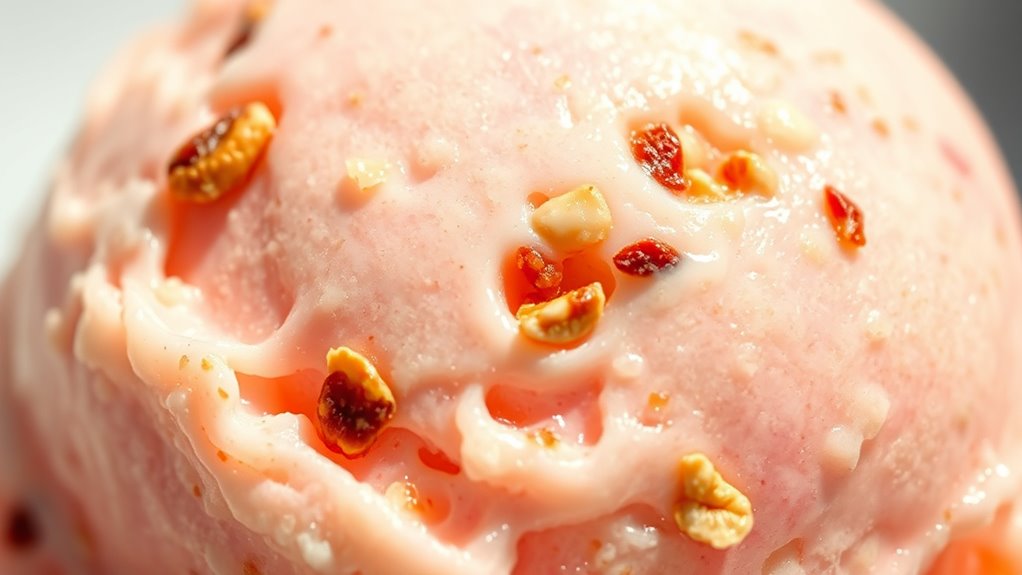Ice cream usually contains low fiber levels, averaging about 0.5 grams per serving. However, incorporating dietary fibers can greatly boost its nutritional value while also enhancing texture. Fibers like inulin or apple fiber not only increase fiber content but also improve creaminess and mouthfeel, leading to a more satisfying dessert experience. Plus, these additions can help reduce fat without compromising taste. Discovering how these fibers impact overall quality could surprise you.
Key Takeaways
- Most ice cream varieties contain around 0.5 grams of fiber per serving, which is considered low compared to recommended daily intake.
- Adding dietary fibers like inulin or citrus fiber can significantly increase the fiber content and enhance health benefits.
- Incorporating about 4% dietary fiber, such as apple fiber, improves texture and creates a smoother mouthfeel in ice cream.
- Specific fibers can modify the freezing point, helping maintain ice crystal size and prolonging shelf life.
- Fiber additives can reduce fat content while maintaining flavor and texture, essential for consumer satisfaction in ice cream.
Nutritional Value of Fiber in Ice Cream

When you indulge in ice cream, you mightn’t think about its fiber content, but it’s worth noting that most varieties contain just around 0.5 grams of fiber per serving. This low amount falls considerably short of the recommended intake for health benefits.
However, incorporating dietary fibers like inulin or citrus fiber can boost the nutritional value of ice cream, raising fiber content to levels that allow for health claims. Adequate fiber not only supports heart health and digestive wellness but also enhances the overall sensory experience of the product.
Enhancing Texture With Dietary Fiber

When you add dietary fiber to ice cream, you can considerably boost its viscosity and creaminess.
This not only controls ice crystal size but also affects the freezing point, enhancing the overall texture.
With the right fiber, you’ll create a smoother, more enjoyable treat that holds up better over time.
Viscosity and Creaminess Impact
Dietary fiber plays an essential role in enhancing the texture of ice cream, as it significantly increases viscosity, which contributes to a smoother and creamier mouthfeel.
When you add around 4% dietary fiber, like apple fiber, you’ll notice a substantial improvement in viscosity, resulting in a creamier texture. This increase in viscosity can also reduce air cell size, leading to higher overrun and a denser product.
Different types of dietary fiber, such as inulin and citrus fiber, can uniquely influence melting quality and overall texture. Plus, certain fibers can help stabilize the freezing point, enhancing creaminess further.
Ice Crystal Size Control
Incorporating dietary fiber not only enhances viscosity but also plays an essential role in controlling ice crystal size in ice cream. When you add about 4% dietary fiber, especially from sources like apple fiber, you’ll notice a remarkable improvement in texture.
This fiber promotes smaller ice crystals, resulting in a smoother mouthfeel and creamier ice cream. Higher viscosity slows down the melting rate, making your treat more enjoyable. Types like inulin can create a texture comparable to traditional samples, enhancing both creaminess and stability.
Additionally, dietary fiber helps maintain ice crystal size during storage, prolonging the quality and shelf life of your ice cream. So, by incorporating fiber, you elevate your ice cream experience considerably.
Freezing Point Modification Techniques
To enhance the texture of ice cream, you can utilize freezing point modification techniques that involve adding specific types of fiber. These fibers increase viscosity, resulting in a smoother, creamier mouthfeel while slowing down the melting rate. For instance, incorporating 4% apple fiber can greatly enhance viscosity and reduce ice crystal sizes.
| Fiber Type | Effect on Texture | Freezing Point Impact |
|---|---|---|
| Apple Fiber | Smoother mouthfeel | Lowers freezing point |
| Inulin | Better texture | Raises freezing point |
| Pectin | Improved melting quality | Lowers ice crystal growth |
The Role of Viscosity in Ice Cream Quality

When you think about ice cream quality, viscosity plays an essential role in how the texture feels on your palate.
By enhancing viscosity with dietary fiber, you’ll notice smaller ice crystals, which contribute to a smoother mouthfeel and better ice crystal stability.
This improvement not only elevates your ice cream experience but also helps maintain its quality over time.
Texture Enhancement Mechanisms
While many factors contribute to the overall quality of ice cream, viscosity plays a crucial role in enhancing its texture. By adding dietary fiber, you can considerably increase the viscosity of your ice cream, resulting in a smoother, creamier texture.
For instance, incorporating just 4% dietary fiber can lead to smaller ice crystal sizes, which enhances the overall mouthfeel. Higher viscosity not only contributes to that desirable creaminess but also helps resist melting, improving your sensory experience.
Different types of dietary fiber, like inulin and apple fiber, can affect melting quality and viscosity uniquely, allowing you to customize your ice cream’s texture.
Ice Crystal Stability
The stability of ice crystals in ice cream greatly relies on the viscosity of the mixture, which directly influences the overall quality of the final product.
By incorporating dietary fiber, particularly apple fiber, you can enhance viscosity, leading to a smoother texture and improved melting resistance.
Here are four key benefits of increased fiber content:
- Smaller Ice Crystals: A 4% fiber addition reduces ice crystal sizes, creating a creamier texture.
- Slower Melting: Higher viscosity slows down melting, enhancing your enjoyment.
- Preventing Growth: Dietary fiber helps stop unwanted ice crystal growth during storage.
- Enhanced Stability: Fibers like inulin elevate the glass conversion temperature, boosting water diffusion barriers.
With these benefits, the right fiber content can greatly improve your ice cream experience.
Freezing Point Depression and Its Effects

Adding dietary fibers like inulin and apple fiber to ice cream not only enhances its nutritional profile but also plays an essential role in freezing point depression.
Incorporating dietary fibers like inulin and apple fiber enhances ice cream’s nutrition and reduces freezing point, ensuring a smoother texture.
When you incorporate these fibers, the freezing point of your ice cream mixture lowers, which helps create smaller ice crystals. This results in a smoother texture that you’ll notice when you take a bite.
Increased dietary fiber content also boosts viscosity, giving your ice cream a creamier mouthfeel and slowing the melting rate due to smaller air cells.
While some fibers may raise the freezing point, inulin greatly enhances the water diffusion barrier, preventing recrystallization during storage.
Properly balancing these fibers guarantees your ice cream maintains its desired texture and quality over time.
Prolonging Shelf-Life With Fiber Addition

Incorporating dietary fibers not only improves texture but also plays a significant role in prolonging the shelf-life of ice cream. By increasing the fiber content, you can enhance your product’s stability and freshness.
Here are some key benefits:
- Reduces ice crystal growth: Dietary fibers minimize recrystallization, maintaining a smoother texture.
- Enhances water diffusion barrier: This helps control unfrozen water, further decreasing ice crystal formation.
- Improves ice cream matrix stability: Fiber types like inulin are particularly effective against ice crystal migration.
- Extends product quality: Properly formulated, fiber-enriched ice cream can last longer, providing consumers with a fresher experience.
Understanding Glass Transition Temperature

Understanding the glass change temperature (Tg) is vital for creating high-quality ice cream, as it determines how the product behaves at low temperatures. Typically, ice cream becomes rigid and brittle below -32°C (-25.6°F).
By incorporating dietary fiber, you can notably increase the glass change temperature, enhancing stability and texture during storage. A higher Tg reduces the mobility of water molecules, minimizing ice crystal growth and recrystallization, which is essential for maintaining smoothness.
For instance, adding inulin effectively elevates the glass change temperature, improving the water diffusion barrier in your ice cream.
Fat Reduction Techniques in Ice Cream Formulation

After exploring the importance of glass change temperature in maintaining ice cream quality, it’s clear that fat reduction techniques play a significant role in formulation.
Exploring glass change temperature highlights the crucial role of fat reduction techniques in ice cream formulation.
By incorporating dietary fibers, you can achieve a healthier product while still ensuring a delightful experience. Here are some effective strategies:
- Inulin: Replace up to 25% of fat at a 3% concentration without sacrificing texture.
- Pre-treated Orange Peel Fiber: Cut fat content by up to 50% while maintaining overall acceptance.
- Apple and Oat Fibers: Enhance fat reduction and texture, with inulin yielding the best results.
- Fiber Additives: Improve nutritional profile, adding health benefits without compromising quality.
These methods allow you to create ice cream with reduced fat content that consumers will love.
Summary of Fiber Testing Results in Ice Cream

Recent testing on fiber incorporation in ice cream has revealed essential insights into how different types affect both flavor and texture.
For instance, adding 4% inulin not only reduces fat by 25% but also maintains a smooth, creamy texture, proving to be the most effective fiber type.
On the other hand, orange fiber can cut fat content by 50% at 1%, but it may leave a bitter aftertaste unless you adjust it to 0.5%.
Meanwhile, 4% apple fiber creates a chewy texture and an undesirable dark red color that didn’t fare well in taste tests.
These results highlight the importance of selecting suitable fiber types to enhance nutritional value without compromising flavor or mouthfeel in your ice cream formulations.
Frequently Asked Questions
Is Ice Cream High in Fiber?
You might be wondering if ice cream is high in fiber. Generally, it’s not.
Most ice cream varieties contain very little fiber, often less than a gram per serving. If you’re looking to boost your fiber intake, you’ll need to be cautious.
Some brands add fiber, but many don’t. To make a healthier choice, consider ice cream with added fiber or mix in some fiber-rich toppings to enhance your dessert experience.
What Is the Healthiest Ice Cream to Eat?
When you think of ice cream, you might picture a decadent treat that’s hard to resist.
But if you want to indulge wisely, look for options like Halo Top, which packs lower calories and higher protein.
You’ll also find varieties with natural sweeteners like stevia that keep sugar levels in check.
Always check for at least 3g of dietary fiber per serving to maximize health benefits while satisfying your sweet tooth.
Enjoy!
How Much Fiber Is in Halo Top Ice Cream?
When you check out Halo Top Ice Cream, you’ll find that it typically contains around 5 grams of fiber per serving, depending on the flavor.
This fiber comes from prebiotic sources, which can be beneficial for your digestive health.
If you’re looking for a tasty dessert that fits into a healthier lifestyle, Halo Top offers a great option, allowing you to enjoy ice cream while also getting some fiber without the regret.
Is Ice Cream Good for Your Digestive Tract?
Imagine your digestive tract as a bustling city. Ice cream, in its classic form, mightn’t be the best road for traffic flow—it’s a bit smooth and slippery.
However, with fiber-enriched varieties, you can pave pathways that support regularity and enhance gut health.
So, while traditional ice cream might slow things down, fiber-enhanced options can keep your city thriving.
Just remember, it’s a treat, not the main highway for fiber!
Conclusion
Incorporating fiber into ice cream isn’t just about nutrition; it’s like adding a secret ingredient that elevates the whole experience. By enhancing texture, improving viscosity, and prolonging shelf-life, fiber plays a vital role in modern ice cream formulation. As you enjoy your next scoop, remember that these advancements not only satisfy your sweet tooth but also contribute to a healthier treat. Embracing fiber in ice cream is a win-win for both flavor and wellness!









